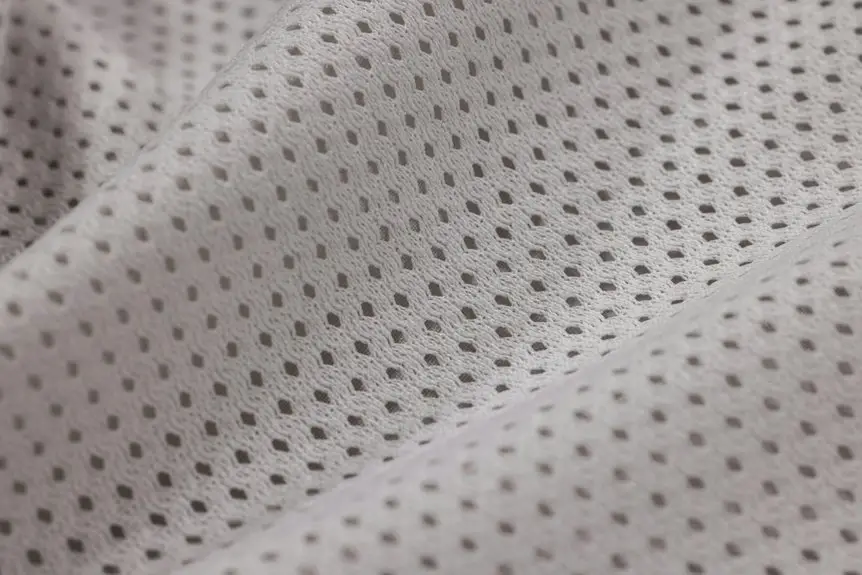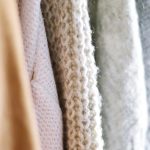You want comfort, and you want breathability—but jersey knit and woven cotton offer these qualities in very different ways. If you’ve ever wondered why one fabric feels cooler or stretches more than the other, it comes down to their unique structures and how they handle airflow and moisture. Understanding these differences can help you choose the right fabric for your needs, whether you’re picking out activewear or casual clothes.
Table of Contents
Key Takeaways
- Jersey knit has tiny gaps between loops, allowing better air circulation and enhanced breathability compared to woven cotton’s tighter structure.
- Woven cotton’s crisscross yarn pattern restricts airflow more but still offers good breathability for casual and sleepwear comfort.
- Jersey knit adapts to body movement, maintaining airflow channels and moisture-wicking for activewear breathability.
- Woven cotton absorbs moisture but dries slower, which can reduce breathability by trapping humidity against the skin.
- Lightweight jersey knits promote superior ventilation through air pockets, while heavier woven cotton fabrics reduce overall airflow.
Understanding the Fabric Structures of Jersey Knit and Woven Cotton
To understand the differences between jersey knit and woven cotton, you need to look at how each fabric is constructed.
Jersey knit is made by interlocking loops of yarn, giving it stretch and a soft, smooth surface. In contrast, woven cotton is created by crossing yarns at right angles, resulting in a firmer, more structured fabric.
Jersey knit’s interlocking loops create stretch and softness, while woven cotton’s crossed yarns form a firm, structured fabric.
These fabric characteristics lead to distinct texture differences. Jersey knit feels stretchy and flexible, making it comfortable for movement, while woven cotton offers a crisp, stable texture.
When you touch jersey knit, you notice its pliability and slight elasticity; woven cotton, however, feels more rigid and durable.
Recognizing these structural and texture differences helps you choose the right fabric for your needs.
How Knit and Woven Fabrics Affect Airflow
When you wear knit fabric like jersey, its loops create tiny gaps that let air circulate more freely, keeping you cooler.
In contrast, woven cotton has a tighter structure that restricts airflow but offers more durability.
Understanding these differences helps you choose the right fabric for comfort and breathability.
Knit Fabric Air Circulation
Although both knit and woven cotton fabrics offer comfort, their structure greatly impacts how air flows through them.
When you choose knit fabric, you benefit from its unique knit texture, which creates small loops and gaps. These allow for enhanced fabric ventilation, letting air pass through more freely. As a result, your skin can breathe easier, and moisture evaporates faster, keeping you cooler.
The elasticity of knit fabrics also helps maintain these airflow channels, even as you move. This flexibility means knit fabric adapts well to your body, ensuring consistent airflow without feeling restrictive.
Woven Fabric Airflow
Since woven fabrics have a tighter, crisscrossed structure, they restrict airflow more than knits do. When you wear woven fabric types like poplin or twill, you’ll notice less breathability because the threads are packed closely together.
This construction limits the airflow characteristics, making these fabrics denser and less ventilated. Unlike jersey knits that allow air to pass freely through their loops, woven fabrics rely on the spacing between the warp and weft threads.
The tighter this weave, the less air moves through, which can trap heat and moisture. So, if you want better ventilation, woven fabrics mightn’t be your best choice, especially in hot weather.
Understanding these airflow differences helps you pick the right fabric for comfort and breathability.
Moisture Absorption and Management in Jersey and Woven Cotton
Because moisture management directly affects comfort, understanding how jersey knit and woven cotton handle moisture is essential. Jersey knit excels at moisture wicking, pulling sweat away from your skin and keeping you dry. Woven cotton absorbs moisture well but dries slower, which can affect humidity control.
Here’s what you’ll notice with each fabric:
- Jersey knit offers quick moisture wicking, ideal for active wear.
- Woven cotton provides strong absorption but may feel damp longer.
- Jersey’s breathability supports better humidity control in warm conditions.
- Woven cotton’s slower drying can trap moisture, reducing comfort.
Knowing these differences helps you choose the right fabric for your comfort, whether you need breathability or moisture management during daily wear or workouts.
The Role of Fabric Weight in Breathability
When you consider breathability, fabric weight plays an essential role in how air flows through the material. Heavier fabrics typically have a higher fabric density, which reduces the spaces between fibers and limits airflow.
On the other hand, lighter fabrics feature lower fabric density, allowing more air to pass through and enhancing breathability. Jersey knits often have weight variations that impact breathability differently than woven cotton.
For example, a lightweight jersey knit feels more breathable because its loops create natural air pockets, while a heavier woven cotton can feel denser due to tighter construction.
Understanding these weight variations lets you choose fabrics that balance durability and airflow, ensuring comfort based on your breathability needs.
Seasonal Comfort: When to Choose Jersey or Woven Cotton
Understanding how fabric weight influences breathability helps you pick the right material for different seasons.
Fabric weight impacts breathability, guiding your choice of materials for comfort throughout the seasons.
During seasonal changes, your fabric preferences play a huge role in comfort. Jersey knit, with its stretch and softness, works wonders in cooler months, keeping you cozy without overheating. Woven cotton, meanwhile, shines in warmer weather by letting air flow freely, preventing sweat buildup.
Consider these tips to boost your seasonal comfort:
- Choose jersey for chilly mornings and cool evenings.
- Opt for woven cotton when the sun’s out and temperatures rise.
- Layer jersey under woven cotton to adapt to fluctuating temps.
- Switch fabrics based on your activity level and sweat tendencies.
Durability and Care Impact on Fabric Performance
You’ll want to contemplate how each fabric handles pilling and keeps its shape over time.
Proper washing and drying techniques can make a big difference in maintaining their look and feel.
Understanding these care tips helps you get the most wear and longevity from your jersey knit or woven cotton pieces.
Pilling and Shape Retention
Although both jersey knit and woven cotton fabrics offer unique textures and comfort, their durability—especially regarding pilling and shape retention—varies considerably.
You’ll notice jersey knits tend to pill more due to their looped fibers, but they often bounce back into shape better. Woven cotton resists pilling well, yet it can lose form faster without proper care.
To help with pilling prevention and shape preservation, consider these tips:
- Choose high-quality fibers for longer-lasting wear.
- Avoid friction-heavy activities that cause fiber damage.
- Store garments folded to maintain their shape.
- Inspect fabric regularly to catch early signs of wear.
Understanding these differences helps you pick the right fabric that fits your lifestyle and keeps your clothes looking fresh.
Washing and Drying Tips
Since proper washing and drying play an essential role in maintaining fabric durability, you should handle jersey knit and woven cotton with care to extend their lifespan.
For washing techniques, use cold water and a gentle cycle for jersey knit to prevent stretching, while woven cotton can tolerate a regular cycle but also benefits from cold water to reduce shrinkage. Avoid harsh detergents that can weaken fibers.
When it comes to drying methods, air drying is best for both fabrics to maintain shape and softness. If you use a dryer, choose a low heat setting and remove items promptly to avoid wrinkles and damage.
Following these washing techniques and drying methods will help preserve breathability and overall fabric performance.
Longevity and Wear Resistance
Proper care directly influences how long your jersey knit and woven cotton fabrics last and how well they hold up over time.
Understanding longevity factors and wear resistance helps you make smart choices to extend your garments’ life. Jersey knits offer flexibility but can snag easily, while woven cotton is more resistant to abrasion but may stiffen if not cared for properly.
To maximize durability:
- Wash in cold water to prevent fiber weakening.
- Avoid harsh detergents that break down fabric strength.
- Air dry or use low heat to protect fibers.
- Store garments properly to prevent stretching or creasing.
Practical Applications Based on Breathability Differences
When choosing between jersey knit and woven cotton, you’ll want to contemplate how each fabric handles breathability, as it directly affects comfort and usability.
Jersey knit, with its stretch and moisture-wicking properties, suits activewear choices perfectly, keeping you cool during workouts. Its breathability allows air circulation while adapting to your movements.
Jersey knit stretches and wicks moisture, providing breathability and comfort ideal for activewear and workouts.
On the other hand, woven cotton offers a crisp feel and excellent airflow, making it ideal for sleepwear preferences where softness and breathability promote restful nights.
You’ll also find woven cotton great for casual shirts and summer dresses because it lets your skin breathe.
Frequently Asked Questions
Can Blending Fibers Improve Breathability in Jersey or Woven Cotton?
Did you know 65% of people feel uncomfortable in non-breathable clothes? You’ll find fiber blends can boost breathability impact, letting your skin breathe better, whether in jersey or woven cotton fabrics, keeping you cool and comfy.
How Does Fabric Color Affect Breathability and Heat Retention?
You’ll notice darker colors with high color intensity absorb more heat, reducing breathability. Heavier fabric weight also traps heat, so lighter colors and lighter fabrics help you stay cooler and breathe easier in warm weather.
Are There Eco-Friendly Treatments to Enhance Cotton Fabric Breathability?
Did you know organic treatments can boost cotton breathability by up to 30%? You can use natural dyes and eco-friendly processes to enhance airflow while keeping your fabric sustainable and chemical-free.
Does the Type of Cotton Fiber (E.G., Pima vs. Upland) Impact Breathability?
You’ll find fiber characteristics like length and fineness affect breathability. Pima cotton’s longer, finer fibers offer pima advantages, making it more breathable and softer compared to upland cotton, enhancing comfort in warm conditions.
How Do Washing Methods Influence the Long-Term Breathability of These Fabrics?
Your washing techniques directly impact fabric care and breathability. Using gentle cycles, cold water, and mild detergents helps maintain fabric structure. Avoiding harsh chemicals and high heat drying preserves breathability, keeping your clothes fresh and comfortable longer.
- What Is Abaca Fiber? the Complete Guide to “Manila Hemp” - June 24, 2025
- Troubleshooting: Why Your Acetate Garment Might Feel Weak or Tear Easily - June 24, 2025
- Acetate vs. Rayon for Lining: Which Is Better for Your Project? - June 24, 2025







